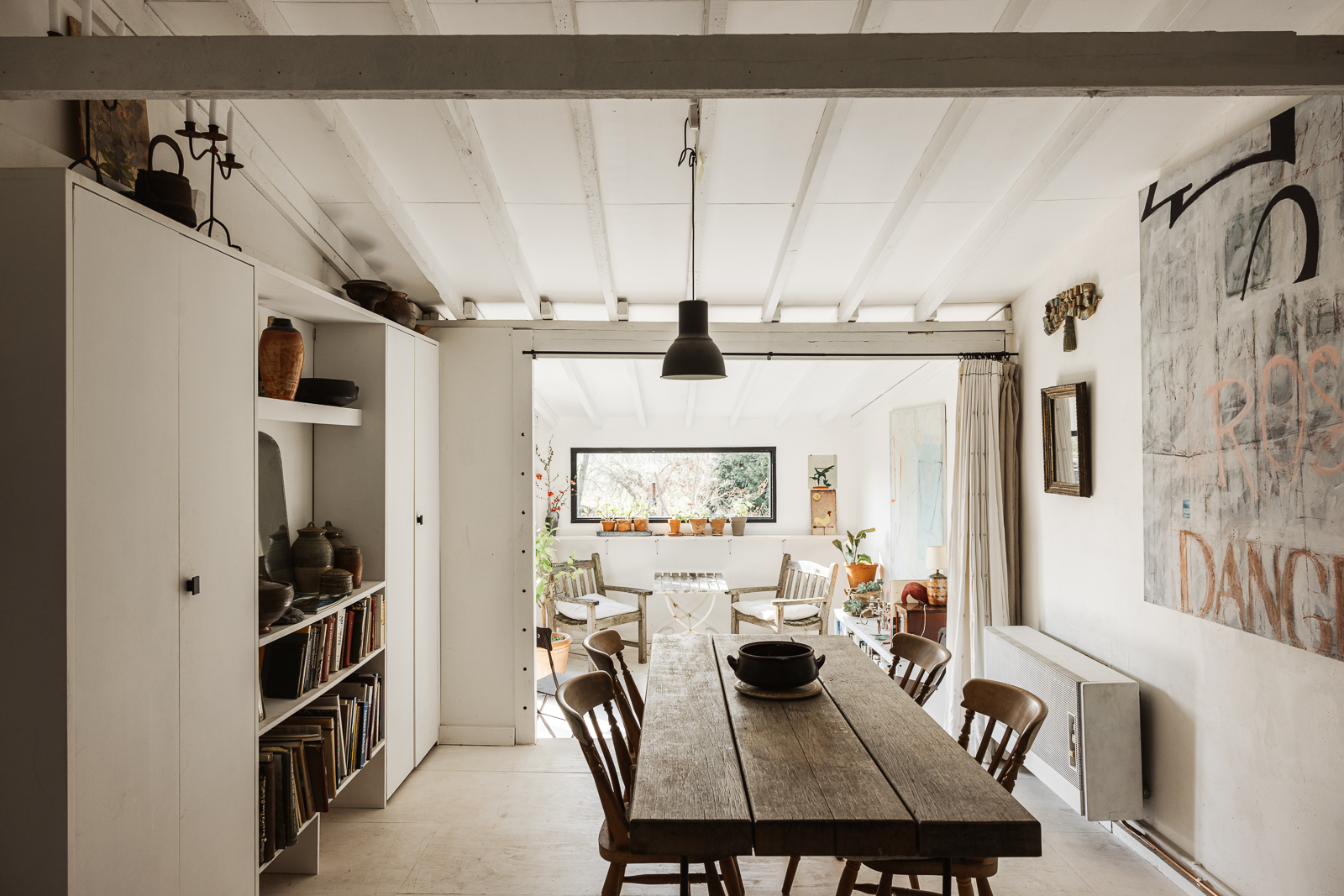Entry is through the original Victorian shop front and immediately to a spacious reception room, with an open-hearth fireplace and arched shop windows set behind shutters. A secondary room is adjacent; it is currently used as a bedroom and would also make an excellent study. Oak flooring runs underfoot and extends through the entire ground floor; here, there is a dining room, secondary kitchen/utility area and separate wet room. A stable door leads from the rear hall to the exterior cart lodge and gardens, while a bedroom is set beneath on the lower-ground floor, with an entrance to the gardens. These rooms can function as independent quarters from the main living accommodation on the uppermost floors or as secondary spaces to connect the entire house.
The current principal living quarters are reached by ascending the box staircase to the first floor. Wonderfully spacious, expansive fenestration is at both east and west aspects. The French windows at the rear lead to a spacious balcony and pergola, wreathed in a beautifully mature wisteria, extending the entire width of the two houses and offering incredible views of the water meadows. One of the two staircases on this floor is cleverly concealed behind a Suffolk latch door and leads to two of the bedrooms on the upper floor.
The main living room connects to the kitchen through one of the house’s many Victorian four-panel pine doors, allowing for a seamless continuation of living quarters. Oak and granite rest atop chalk-white panelled cabinetry, while the house’s original pitch pine boards are washed in a similarly pale hue. A wood-burner acts as a focal point in this room, with further French windows leading to the timber balcony that connects the entire floor’s plan.
A bathroom is positioned on this floor, at the base of a private staircase that leads solely to the main bedroom on the second floor. Set within the roof’s pitch, this room is incredibly spacious and bright, with exposed rafters and joists lending strength and character to the space. A wall of storage cupboards is discreetly set behind louvre doors; a casement window opens to the very best views in the entire house. A Jack and Jill shower room connects to two further bedrooms, which have their own entrance leading from the staircase rising from the dining room below.
The Great Outdoors
Set in around a quarter-acre plot and west-facing, the exterior buildings and mature private gardens lead from the main house down a gentle incline, culminating at a tributary of the River Stour that acts as an aquatic ha-ha. An uninterrupted sight line of the water meadows beyond allows for a gloriously bucolic backdrop through the rushes.
A path leads to a brick-paved terrace, surrounded by crab apple trees and a stunning magnolia tree. The first outbuilding is a vast studio configured as two main rooms, clad in weatherboard with a corrugated roof; the pitched ceiling features exposed joists internally. Currently used as an potter’s studio and secondary living space, it is painted in chalky whites and has its own wet room. Belgian gas heaters warm the spaces, and a landscape window to the rear cleverly frames beautiful views to the meadows beyond. French windows lead to a further terrace with room for additional seating.
The lower gardens widen and encompass further exterior buildings, including a secondary light-filled studio and a kiln shed. The expansive lawn has extensive mature planting, including a centrally positioned mature apple tree – a vestige of the times when these gardens acted as an orchard for a nearby priory. At the very end of the garden is a summer house, painted pale blue internally, with French doors that open directly to the river Stour and water meadows. The position and views are exceptional and extend across the landscape that Gainsborough and Constable found compelling; the house enjoys extraordinary sunsets. Grazed in the spring and summer months, the area is botanically rich and an ornithologist’s delight.
Out and About
Sudbury town offers excellent amenities, including a weekly farmers market and a large branch of Waitrose. The Cradle is a very popular local independent plant-based bakery and restaurant situated upon North Street, while
The Mill Hotel is a popular local spot for drinks and dinner beside the river and is particularly popular with dog owners, happily welcoming four-legged friends. The village of Long Melford is a short drive away, with its excellent antique shops, pubs and restaurants, including
The Swan,
The Black Lion and
Nethergate Brewery.
Clark and Son are a famed local butcher, while
Turners Fishmongers operate from the nearby and excellent Willow Tree farm shop on Saturdays. Long Melford Village Bakers are the favoured supplier for artisan bread and pastries. Further and more extensive amenities, restaurants and shops are in Bury St Edmunds to the north of Colchester to the south, both a 30-minute drive away.
For further recreation and not far from Sudbury is the famed historic town of Lavenham, housing some of England’s finest examples of medieval architecture. Incredibly pretty, most houses are timber-framed and still evidently Tudor. The nearby fashionable Suffolk coastal towns of Aldeburgh, Southwold and Walberswick offer a wonderful opportunity for days out in warmer months.
There is a very good choice of schools, with independent options including Stoke College, Great Buckenham Hall, Finborough School, Culford School and Old Baradiston Hall. All offer bus collections and drop-offs. The favoured state secondary schools are Thomas Gainsborough in Sudbury and Stour Valley Community School in nearby Clare. Local primaries within Sudbury are excellent and include St Gregory CoE school and St Joseph’s RC school.
Transport links are easily accessible. Sudbury train station is a short walk from the Silk Weaver’s House, with the two-track Gainsborough line connecting with trains at Marks Tey. The seamless connection means trains reach London Liverpool Street from Sudbury door-to-door in 78 minutes precisely.
Council Tax Band: A&B
